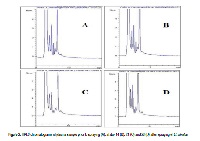Spraying of swine buildings with lemon grass (Cymbopogon citratus) essential oil does not produce blood absorption in swine
Keywords:
Citral, C. citratus, Plasma, Spray, SwineAbstract
Cymbopogon citratus (Lemon grass) essential oils have been used in swine buildings to reduce the offensive odor emanating from swine buildings. The present study was designed to investigate plasma residues of citral which is a major constituent of the essential oils of Cymbopogon citratus. An HPLC method was established, validated and used for the determination of citral in swine plasma harvested from blood samples taken at the 14th, 21st and 28th day after spraying swine buildings with the 3% Lemon grass essential oil. Thereafter, analysis of the sample was conducted using HP ODS Hypersil column (200 × 4.6 mm, 5 µm) with a mobile phase consisting of methanol and 0.5% acetic acid; and a flow rate of 1mL/ min. The method was validated for parameters such as accuracy, precision, linearity and detection limits. Plasma spiked with standard citral (95%) revealed two chromatograms with retention times of about 10.7 and 12.2 minutes. The calibration curves for the citral isomers were found to be linear in the tested concentration ranges and mean recoveries wre 101% and 99.17%. This method was used to determine the residues of citral in swine plasma pretreated with methanol. Surprisingly, there was no any detectable level of citral in swine plasma within the 28 days of exposure. spraying of swine buildings with essential oils of lemon grass oil does not cause plasma residues of citral.
References
Swine
Full Text:
References
Hobbs PJ, Misselbrook TH, Pain BF. Characterization of odorous compounds and emissions from slurries produced from weaned pigs fed dry feed and liquid diets. J. Sci. Food Agric. 1997; 73: 437–445.
Varel VH, Miller DN. Plant-derived oils reduce pathogens and gaseous emissions from stored cattle waste. Appl. Environ. Microbiol. 2001; 67: 1366–1370.
Mackie RT, Stroot PG, Varel VH. Biochemical identification and biological origin of key odor components in livestock waste. J. Anim. Sci. 1998; 76: 1331–1342.
Zhu J, Riskowski GL, Torremorell M. Volatile fatty acids as odour indicators in swine manure – a critical review. Trans. ASAE. 19994; 2: 175–182.
Jacobson L, Johnston L, Hetchler B, Janni K. Odor emissions control by sprinkling oil for dust reduction in pig buildings. Trans. ASAE. 2000; 43: 413–420.
Takai H, Moller F, Iversen M, Jorsal SE, Bille-Hansen V. Dust control in pig houses by spraying rapeseed oil. Trans. ASAE 1995; 38: 1513–1518.
Zhang Y, Tanaka A, Barber EM, Feddes JJR. Effects of frequency and quantity of sprinkling canola oil on dust reduction in swine buildings. Trans. ASAE. 1996; 39:1077–1081.
McCrory DF, Hobbs PJ. Additives to reduce ammonia and odor emissions from livestock wastes: a review. J. Environ. Qual. 2001; 30: 345–355.
Carlini EA, Contar JDP, Silva-Filho AR, Silveira-Filho NG, Frochtengarten ML, Bueno OFA J. Pharmacology of lemongrass (Cymbopogon citratus Stapf). I. Effects of teas prepared from the leaves on laboratory animals. Ethnopharmacol. 1986; 17:37–64.
Onawunmi GO, Yisak WA, Ogunlana EO. Antibacterial constituents in the essential oil of Cymbopogon citratus (DC.) Stapf. . Ethnopharmacol. 1984; 12: 279–286.
Viollon C, Chaumont JP. Antifungal properties of essential oils and their main components upon Cryptococcus neoformans. Mycopathologia 1994; 128: 151–153.
Wannissom B, Jarikasem S, Soontorntanasart T. Antifungal activity of lemon grass oil and lemon grass oil cream. Phytother Res. 1996; 10: 551–554.
Pedroso RB, Ueda-Nakamura T, Dias Filho BP, Cortez DAG, Cortez LER, Morgado-Dı´az JA, Nakamura CV. Biological activities of essential oil obtained from Cymbopogon citratus on Crithidia deanei. Acta Protozool 2006; 45: 231–240.
Lawrence BM. Progress in Essential Oils 1976-2000. Allured Publishing Corporation, Carol Stream, IL ; 2003
Pengelly A. The Constituents of medicinal plants (Eds): An Introduction to the chemistry and therapeutics of herbal medicine. United Kingdom: CABI Publishing; 2004.p. 85-103.
Vázquez-Briones MC, Hernández LR, Guerrero-Beltrán JA. Physicochemical and Antioxidant Properties of Cymbopogon citratus Essential Oil. JFDR 2015; 4(3): 36-45.
Schaneberg BT, Khan IA. Comparison of extraction methods for marker compounds in the essential oil of lemongrass by GC. J. Agric. Food Chem. 2002; 50: 1345-1349.
International Conference on Harmonization of Technical Requirements for Registration of Pharmaceuticals for Human Use (ICH) Q2B. Guideline on Validation of Analytical Procedures – Methodology, 1996.
United States Pharmacopoeia, Validation of Compendial Methods, 27th ed. United States Pharmacopeial Convention, Rockville, 2004.
Raubera CS, Guterresa SS, Schapovala EES. LC determination of citral in Cymbopogon citratus volatile oil. J Pharm Biomed Anal 2005; 37:597–601.
Araneda RC, Peterlin Z, Zhang X, Chesler A, Firestein S. A pharmacological profile of the aldehyde receptor repertoire in rat olfactory epithelium. J Physiol 2004; 555: 743–756.



